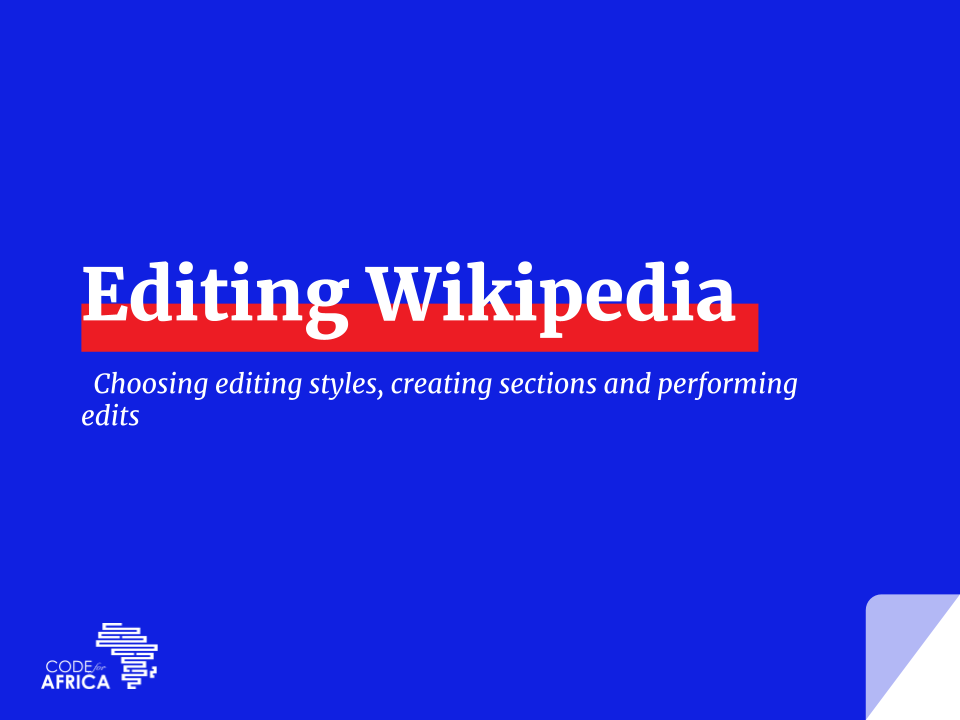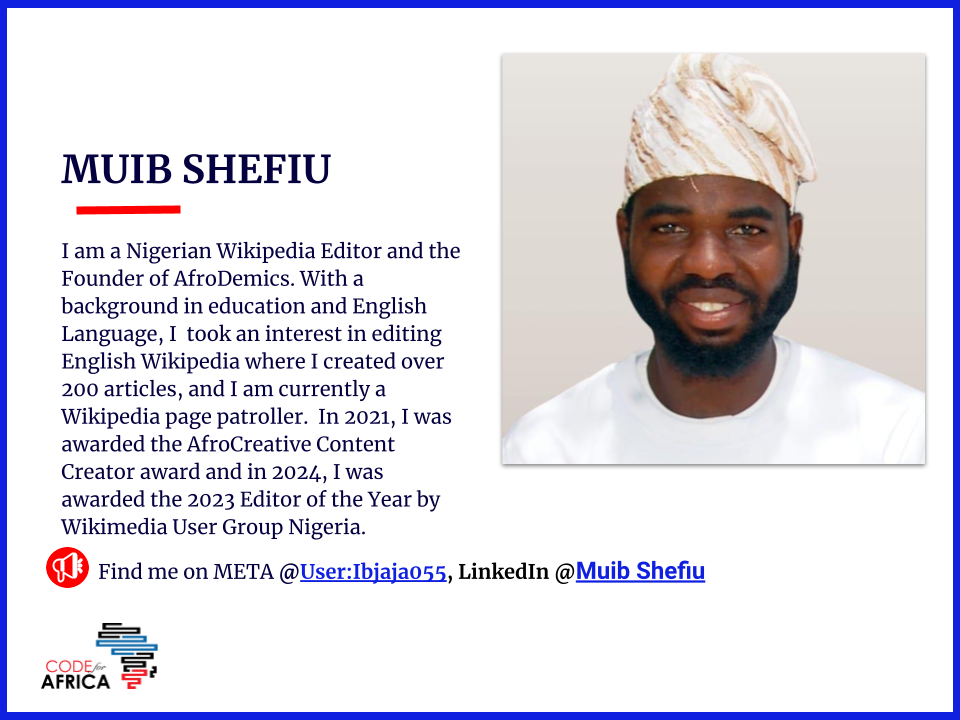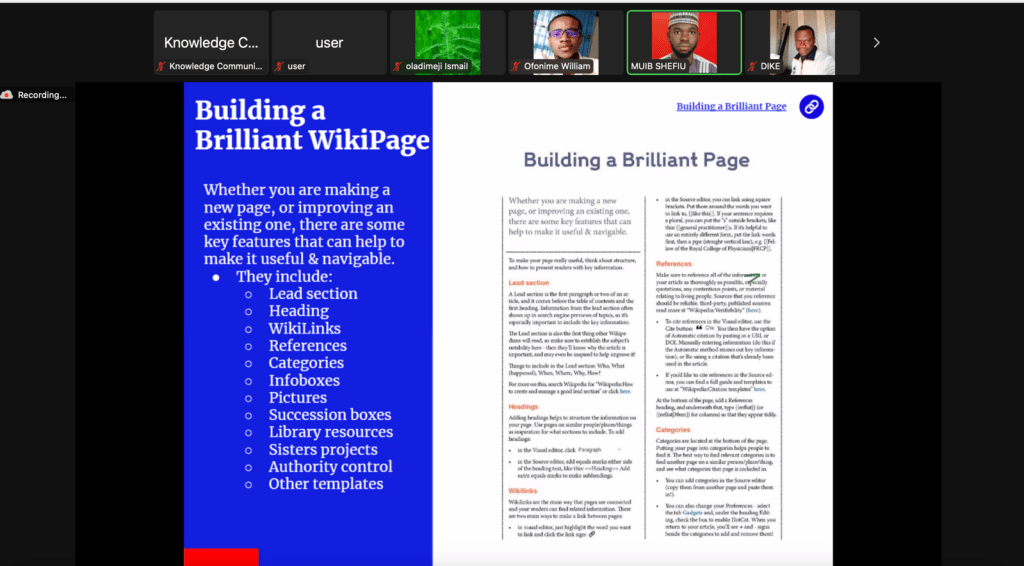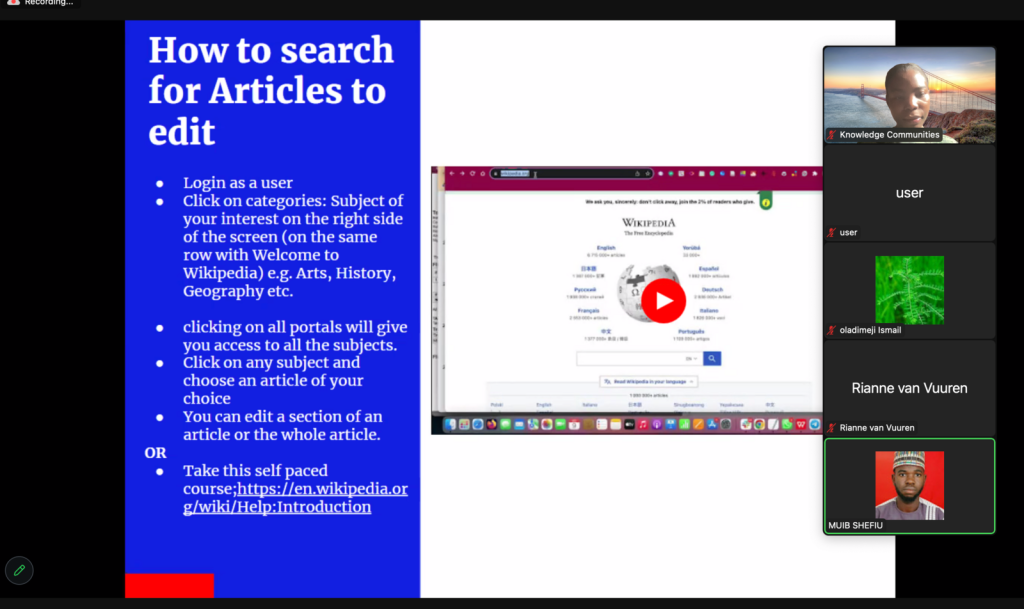
On 7th of February 2024, Code for Africa’s Wikipedian-in-Residence (WiR), hosted the 2nd of the WiR bi-weekly webinar series in 2024, titled “Editing Wikipedia,” the webinar was facilitated by Muib Shefiu, the Founder of Afrodemics, and moderated by Bukola James, the Community Coordinator, CFA-WIR. This session had in attendance 14 participants which consisted of project leads and volunteer Wikimedians from Cameroon, Ghana, Kenya, Nigeria, and Uganda. It provided a comprehensive explanation and practical guide on different types of editing styles, Wiki markup languages, and building a Wikipedia page from scratch.


Key highlights
The webinar commenced with a summary from the previous webinar on Joining Wikipedia and then proceeded into editing Wikipedia . In this session, understanding how to search for articles, editing in Wiki markup interface, using Visual editor, switching between different editing styles and creating an editing summary were discussed. Other areas covered during this webinar includes; building a brilliant Wikipedia page, where the importance of adhering to the key features that can help make it useful and navigable to readers was underscored. This was an essential part of the session as it instilled an understanding of the responsibilities and norms associated with being a Wikipedia editor. The webinar included a practical session guiding participants through the theoretical aspect of the policies and technical aspects of creating and expanding Wikipedia articles from scratch.


Furthermore, the webinar provided an in-depth look at the key features of a Wikipedia article, highlighting the importance of creating or improving pages with elements that enhance both readability and navigability. Among these features are:
- Lead Section: This is the introductory paragraph(s) that precede the table of contents, summarising the key points of an article. It’s crucial for search engine previews and establishes the article’s significance, adhering to the essential components of Who, What, When, Where, Why, and How. Guidance on crafting a compelling lead section can be found in Wikipedia’s resources.
- Headings and Subheadings: Adding headings structures the information on your page and should reflect similar sections found in pages on related topics. They can be easily added using the Visual or Source editor.
- WikiLinks: These internal links connect your article to related content, facilitating reader navigation. They can be inserted via both editing interfaces to enhance your article’s integration into the wider wiki.
- References: Following the Verifiability Principle, all information must be backed by reliable sources. The absence of citations, especially for facts, quotes, or contentious claims, risks content deletion. Wikipedia does not prescribe a fixed citation style but emphasises consistency across articles.
- Categories: Positioned at the bottom, categories improve an article’s discoverability. Similar pages can inspire relevant category inclusion, which can be easily added or adjusted, even with tools like HotCat for efficiency.
- Infoboxes: These boxes on the right of articles summarise key details and are editable or addable via templates. They provide a snapshot of the most pertinent information to the reader at a glance.
- Pictures: Visuals significantly enhance articles, offering insights and engagement beyond text. Wikimedia Commons is a valuable resource for finding images compliant with Wikipedia’s use policy.
- Succession Boxes, Library Resources, Sister Projects, Authority Control, and other Templates: These elements further enrich articles, providing structured paths to related content, authoritative verification, and additional resources for deeper exploration.
Additionally, participants learned to utilise the Wikipedia editing tools like the VisualEditor and Source Editor effectively, tailoring these tools to fit their personal editing preferences and also instilling an understanding of Wikipedia’s core content policies, ensuring the production of valuable, reliable, and accessible knowledge for all.
Conclusion
The session was concluded with a Q&A session and words of encouragement from the facilitator, Muib who encouraged participants to actively engage in Wikimedia community discussions, enhance their skills in creating and expanding articles to address content gaps, and strictly adhere to Wikipedia’s core content policies like neutrality and verifiability.
For those interested in revisiting the session or those who might have missed it, the recorded version is available on the community programmes page and do well to test your knowledge on our academy Africa. Ensure you are registered for the upcoming CfA WiR Bi-weekly webinar and immerse in our vibrant community. To stay abreast of our initiatives, complete this form, and let’s shape the future together!

Can you help us translate this article?
In order for this article to reach as many people as possible we would like your help. Can you translate this article to get the message out?
Start translation